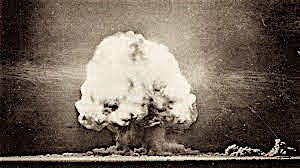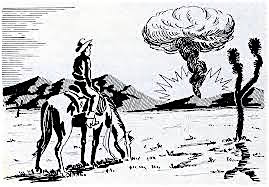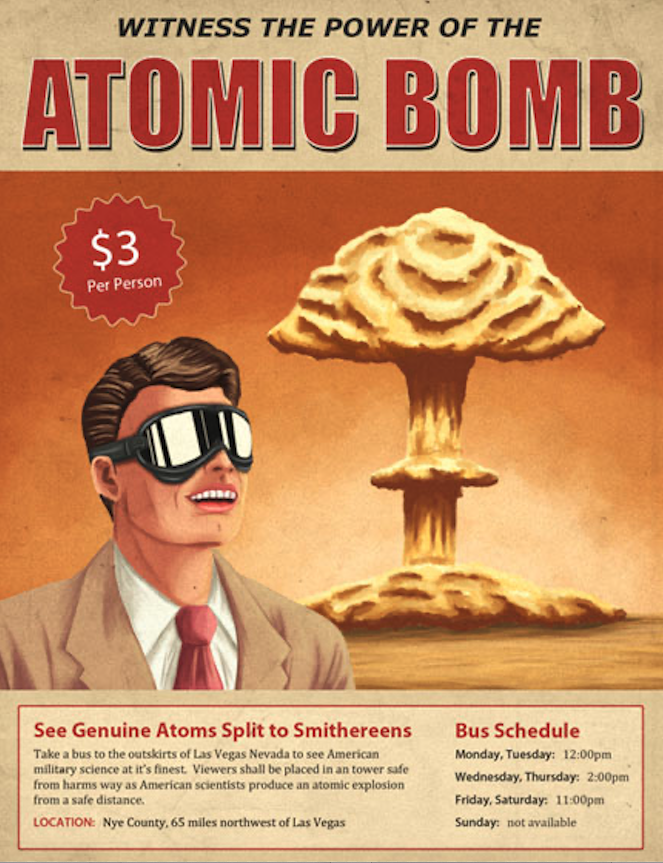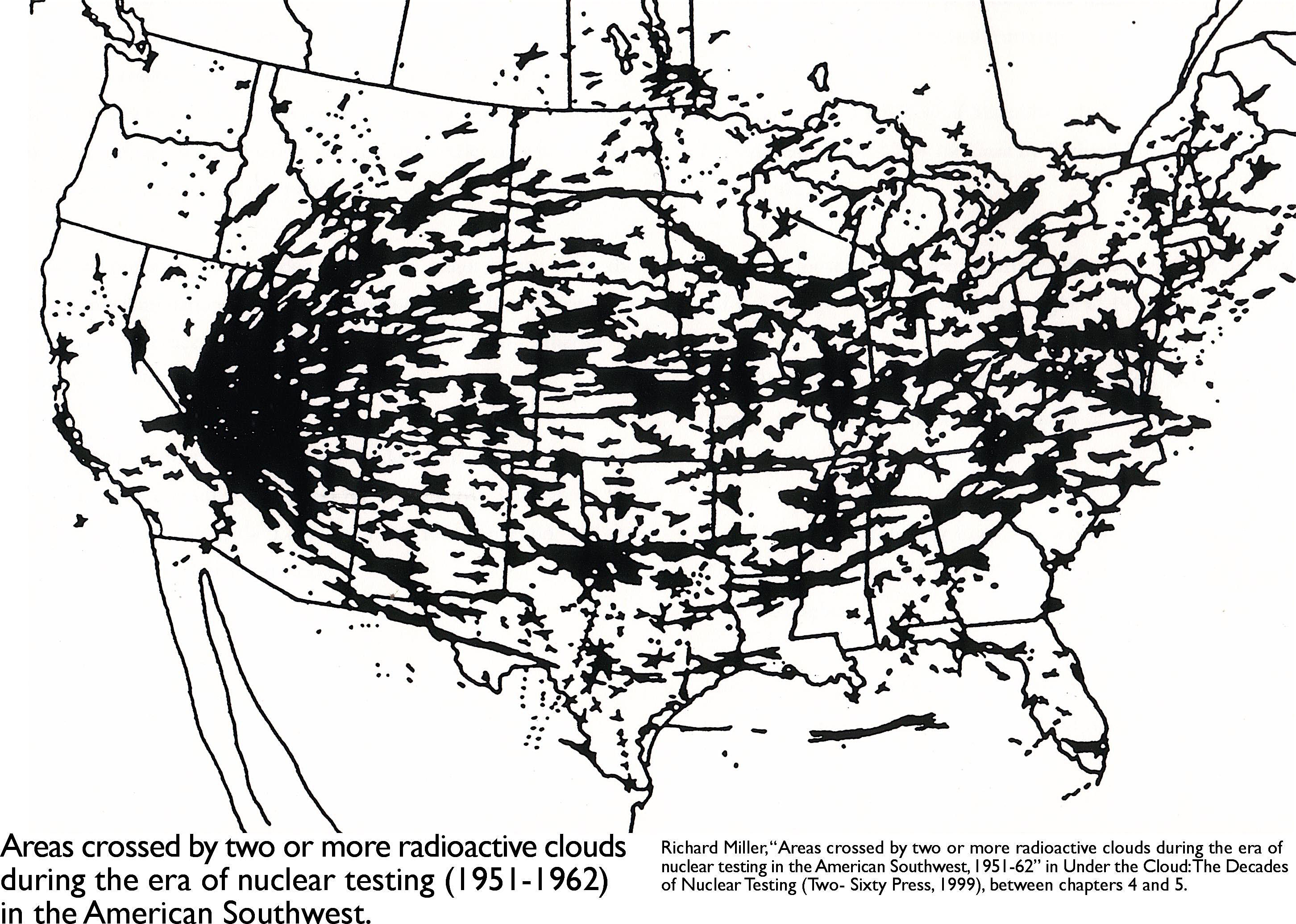By Stan Holmes
"Now I am become Death, the destroyer of worlds." This verse from the Hindu scripture, Bhagavad Gita, crossed physicist Robert Oppenheimer's mind as he witnessed this world's first atomic explosion (code named "Trinity") at Alamogordo, New Mexico on July 16, 1945. Within a month, U.S. atomic bombs leveled the Japanese cities of Hiroshima and Nagasaki.

Trinity Explosion: The first atomic bomb test on July 16, 1945 in Alamogordo, NM
Utah and the Enola Gay
The Hiroshima bombing crew had trained aboard their B-29 bomber, the Enola Gay, at Wendover Army Air Base. On this 75th anniversary year, the Enola Gay Hangar remains a memento not only to the dawn of atomic warfare, but to a sweeping array of linkages Utah has to the nuclear age. From uranium mining to nuclear weapons, waste, and commercial power programs, Utah has been, and remains, at the center of debates over the wise use of split atoms.
U stands for Uranium
Utah's uranium deposits are concentrated in the southeastern part of the state. Clusters of mines in Grand and San Juan counties sent uranium ore to places like White Mesa to be milled into a concentrate called "yellowcake." From the late 1940s to the early 1990s, Utah was a significant fuel source for the nuclear age. It's first uranium boom fueled the nuclear weapons program. Plutonium generated by uranium fission was used in the Trinity and Nagasaki bombs.
The next boom fueled commercial nuclear power plants. There are over 500 mostly-inactive uranium mines in Utah. Production has been negligible for much of the past 30 years due to low uranium prices and difficulty securing investors and construction permits for nuclear reactors. The situation is changing, however, as new reactor designs, the CO2-fueled climate crisis, and Trump administration priorities suggest new demands for nuclear power and weapons.
Casualties of Mining
Uranium ore emits radon gas, which medical science has linked to increased incidence of lung cancer. Radon concentrations can be very high in unventilated mines, as was the case in the 1950s. Uranium miners in the town of Marysvale, on US 89 south of I-70, suffered rates of lung cancer estimated at five times the expected rate. And this among non-smoking Mormon workers. Navajo miners further south also paid a steep price to produce nuclear bomb and reactor material. Researchers with the National Institute for Occupational Safety and Health studied mortality among Navajo uranium miners during the 1960-1990 period and, in 1994, reported a cancer death rate 33% higher than would be expected.

Atomic Cowboy: This image appeared in an early 1950s Atomic Energy Commission pamphlet assuring Utahns there was no danger from atomic bomb fallout.
A Nuclear Family: Reactors and Bombs
"Nuclear power and nuclear weapons: the connection is dangerous," wrote physicist John Holdren, who served as Director of Science and Technology Policy during the Obama Administration. Utahns have seen that connection play out over several decades.
Currently, there are no commercial nuclear reactors in Utah nor, so far as we know, any nuclear weapons deployed. However, the University of Utah's Nuclear Engineering Program has a low-level TRIGA research reactor on campus and several Utah businesses build components for nuclear missiles based elsewhere. TRIGA reveals a nuclear bombs/reactors link in that the development team included "father of the hydrogen bomb" Edward Teller. A side note: "U" rival BYU had a small reactor until 1992.
Commercial Nuclear Development
Emery County's San Rafael Energy Research Center hosts a Center of Excellence studying molten salt reactor (MSR) nuclear technology powered by thorium. Meanwhile, several Utah towns with independent electric utilities are investing in a small modular nuclear reactor (SMR) being developed for 2026 operation at the Idaho National Energy Lab (INEL). The SMR permitting process is proceeding through the Nuclear Regulatory Commission, which is successor to the Cold War Era's Atomic Energy Commission. And ever waiting in the wings is the 2007 proposal by Blue Castle Holdings to construct a two-reactor nuclear facility near Green River. The project, approved to use 50,000 acre feet of water annually, is financially hobbled by costs that have risen from $3 billion to $20 billion.
N-Weapons Research: No Nukes Directly
With regard to military applications, no nuclear warhead labs or production facilities exist in Utah. However, Salt Lake City is geographically central to a weapons development and waste transportation network linking facilities in several western states. They include Los Alamos and Sandia labs in New Mexico, Lawrence Livermore in California, and others in Idaho (INEL) and Washington (Hanford). Thus far, there have been no nuclear facility accidents in Utah. The closest was a 1961 explosion that killed three technicians at the U.S. Army's SL-1 reactor lab near Idaho Falls.
Utah's Downwinders
Uranium miners weren't the only Utahns sacrificed to build America's Cold War nuclear arsenal. Despite assurances from the U.S. Government's Atomic Energy Commission (AEC) that there was no danger, southern Utahns were repeatedly exposed to radiation from uranium and plutonium bomb tests at the Nevada Test Site (NTS) located 65 miles north of Las Vegas.
Government scientists knew by 1950 that fallout from nuclear explosions was in fact dangerous; and, bomb tests were conducted when winds would blow radiation clouds away from Las Vegas and California. The preferred path was toward Utah, where residents were poisoned directly from fallout and indirectly through radioactive iodine that concentrated in cattle forage and made its way into children's milk.
Preston Truman, of Enterprise, Utah attributes his thyroid cancer to this secondary contamination. Truman went on to become a leader of the group Downwinders, as victims of the Nevada nuclear tests came to be known. His story and those of others are told through playwright Mary Dickson, herself a Utah downwinder, in her 2007 play "Exposed". Carole Gallagher's American Ground Zero: The Secret Nuclear War (1993, MIT Press) chronicles the experiences of soldiers, ranchers, and others sacrificed at and downwind of the NTS.
Nevada bomb tests were conducted from 1951 to 1992. In 1962, all explosions went underground, though several blasts still vented radioactive dust into the atmosphere. Bomb test fallout was not confined to Utah. Collective radiation cloud footprints of the 1,021 Nevada nuclear tests show fallout patterns eastward across the U.S. and into Canada. In 1951, Eastman Kodak, in Rochester, New York, threatened to sue the federal government because fallout radiation was fogging its film. The AEC agreed to warn Kodak about fallout clouds, but the general public was kept uninformed and exposed.
The Downwinders saga is not yet over. In 1990, after seeking justice for years, Utah downwinders and uranium industry workers won restitution ranging from $50,000 to $100,00 under the Radiation Exposure Compensation Act (RECA). In Utah, only downwinders from Millard County south are compensated. The RECA program ends in 2022, although Congress is considering legislation [H.R.3783] that would extend the program and expand its geographical area of eligibility.

Witness Atomic Bomb: A promotional flyer encouraging Las Vegas visitors to safely view atomic blasts.
Cold War Reality Hits Utah: The MX
In 1979, following the Three Mile Island nuclear accident, Utah residents were shocked by news that the U.S. Air Force planned to build a system of 200 mobile MX nuclear missiles on "racetrack" loops in desert valleys across Utah and Nevada. The nuclear arms race was no longer an abstraction. It was pounding on our door.
Utah's political leadership, led by U.S. Senators Jake Garn and Orrin Hatch, welcomed and promoted the new ICBM system. [ICBM: Intercontinental Ballistic Missile] Utah military contractors Hercules and Thiokol would build MX missile motors. And since the federal government controls 63% of Utah and 80% of Nevada, the land MX needed could easily be condemned. MX proponents figured the program was a 'done deal'.
They figured wrong. Utah civic groups that included downwinders and the Sierra Club joined an expanding, diverse assemblage of religious, community service, and trade associations that found common ground to face a common enemy: the MX. The two-year "Stop MX" campaign to educate and engage the public peaked with the LDS Church's anti-MX statement in May 1981. The Air Force, Garn, and Hatch had to look elsewhere. Great Basin MX was defeated.
The MX experience was a plus on several fronts. The Utah-Nevada citizens' victory was a grassroots blow against a seemingly endless US-Soviet competition for ever higher levels of nuclear overkill capacity. Petitions, rallies, and group-by-group sign-ons had beaten a multi-million dollar Pentagon promotional effort. More Utahns visited the West Desert to see that it was not the expendable "waste land" disparaged by MX promoters. Bonds forged by the Utah-Nevada Great Basin MX Alliance continue to this day through organizations like the Great Basin Water Network.
Utahns learned about public empowerment channels made possible by federal statutes called National Environmental Policy Act (NEPA) and Federal Lands Policy and Management Act (FLPMA). Hopefully, one MX residual effect in Utah will be public resistance to current efforts by the Trump administration to undermine these tools of American democracy.
The nascent Nuclear Freeze Campaign also gained Utah activists, scores of whom were arrested repeatedly for protesting at the Nevada Test Site. There, they learned Gandhian principles of Nonviolent Direct Action (NVDA). Several Utahns participated in the 1986 Great Peace March across America and its subsequent iteration in the Soviet Union.

Stop MX bumper sticker: Grassroots activists sold MX bumper stickers and t-shirts to fund the campaign.
Don't Waste Utah
Utahns tracking nuclear issues groaned when the home court of the Utah Jazz changed its name from Delta Center to EnergySolutions Arena. A spin-off of the scandal-ridden Envirocare, EnergySolutions is about nuclear fuel and nuclear waste. The company operates its Class A waste disposal facility at Clive, Utah, located 60 miles west of Salt Lake City. In 2018, it sought to store Class A depleted uranium munitions at the site, but was denied permission by state regulators because the material gets more radioactive over time and would exceed the Class A maximum. The Sierra Club joined HEAL Utah in a successful effort to thwart the latest EnergySolutions 'dump on Utah' plan.
This was just the latest in several efforts to dump nuclear waste in Utah. In 2012, Private Fuel Storage lost its bid to "temporarily" store the nation's entire stockpile of high-level commercial reactor waste --all 44,000 tons-- on the Skull Valley Goshute reservation. Turns out the site was too close to a military testing range, so otherwise anti-environment Representative Rob Bishop actually proposed a wilderness area to block the rail link PFS needed to transport the waste. Don't mess with Bishop's Pentagon pals!
Some radioactive waste generated here remains here. Approaching Moab from the north, one passes the Atlas Uranium Mill site where waste from the largest U.S. uranium deposit was processed for yellowcake. The tailings [waste] pond leaked toxins into the nearby Colorado River. The Atlas site also accepted waste from the Vitro Chemical mill that processed uranium and vanadium ore near 3300 South and I-15 in Salt Lake City. Atlas tailings are still being moved from Moab to a new location near Crescent Junction, Utah at a cost estimated to exceed $700 million.
Utah is also likely to see some of the high-level nuclear waste in transit from U.S. nuclear reactors and military facilities to Consolidated Interim Storage (CIS) facilities in Texas and New Mexico. And if the nation's first long-term storage site is ultimately approved for Yucca Mountain, Nevada. Utah could see more 'hot' waste on our roads and railways than any other state. This concern was raised by the Sierra Club, HEAL Utah, and other groups last year in a letter to Governor Herbert about secret shipments of weapons-grade plutonium from South Carolina to Nevada.
Nuclear Challenges à la Trump
The Donald Trump administration has been breathing new life into U.S. nuclear weapon and commercial reactor programs. Driven by Trump's "America First" credo, the U.S. will mine and process more uranium to fuel "advanced" nuclear reactors now being ushered through the licensing process. Arms control treaties are being jettisoned to allow nuclear weapon upgrades justified by manufactured threats likely to become self-fulfilling prophesies.
Since coming to office in 2017, Donald Trump has abandoned the Iran Nuclear Agreement and the Intermediate-Range Nuclear Forces [INF] Treaty. The administration has indicated it will not extend the New Start Treaty that caps U.S. and Russian arsenals at 12,000 total nuclear warheads and is being urged to "unsign" the Comprehensive Test Ban Treaty. The latter two actions could open the door for a resumption of nuclear bomb testing in Nevada and/or the Pacific Ocean, where islanders were also exploited as Cold War expendables. On resuming the nuclear arms race, Mr. Trump's arms control envoy Marshall Billingslea recently claimed that the U.S. is ready to spend Russia and China "into oblivion" to prevail.
In Utah, and with regard to long-range missile delivery systems, Northrop Grumman Aerospace last year broke ground near Hill Air Force Base for a strategic nuclear missile "modernization" facility. Grumman CEO Kathy Warden called the project a national security priority, and noted that historically much of the ICBM support work has been done in Utah.
Utah has at least one mothballed missile launch site. In the 1970s, U.S. and German forces fired nuclear-capable intermediate range missiles from the Green River Launch Complex to impact targets at the U.S. Army test range at White Sands, New Mexico. The site now houses uranium mill waste. With the U.S. out of the INF Treaty, will nuclear-capable missile tests resume at Green River? Possibly.
What's needed? More uranium.
In 2019, the Trump administration created a Nuclear Fuel Working Group dominated by nuclear power advocates. Its mission: to "revive and strengthen the [U.S.] uranium mining industry" and "recover our position as the world leader in exporting best-in-class nuclear energy technology." This group, operating under the Department of Energy, wants to "streamline NEPA and National Historic Preservation Act reviews" and see "categorical exclusions for uranium mineral exploration and development activities." Arizona congressman Raúl Grijalva warns that the Trump administration is using the COVID-19 pandemic as cover while the NFW Group pursues new uranium mining around the Grand Canyon.
[Note that the Department of Energy also oversees nuclear weapons production and testing.]
And for Utah? More uranium mining, plus 'hot' waste shipments from as far away as Estonia.
Where the heck is Estonia? Many Utahns won't be able to find it on a map; but if Energy Fuels Resources has its way, radioactive waste from the Baltic nation will find its way to Utah. EFR's White Mesa uranium mill site in San Juan County would leach uranium from the waste and put the residue in tailings ponds that the Ute Mountain Ute Tribe says are already leaking toxins into the groundwater. To address that issue, EFR is asking the state's Division of Waste Management and Radiation Control to lower the standard for groundwater contamination. The White Mesa mill might also process uranium ore coming from the Bears Ears area.
Lessons Learned
There's much more to Utah's nuclear legacy and current machinations as one digs ever deeper into the weeds. What becomes readily apparent, though, is that while there is a powerful special interest sector promoting nuclear power and weapons in Utah, its well-heeled and funded numbers are relatively small when compared to the broader set of public stakeholders whose interests are impacted by nuclear policy decisions.
Do Utahns benefit from more tax dollars spent on nuclear? In "Nuclear Power Is Too Risky", Stanford civil engineer Mark Jacobson wrote that "[E]very dollar spent on nuclear is one less dollar spent on clean renewable energy and one more dollar spent on making the world a comparatively dirtier and a more dangerous place, because nuclear power and nuclear weapons go hand in hand." How do Utahns benefit from uranium mining that puts radioactive poisons into groundwater and sends dangerous wastes across our transportation infrastructure? Haven't we learned the lessons of Hiroshima, the Downwinders, and Chernobyl?

Nuclear Fallout Map 1951: The U.S. government was tracking radioactive fallout patterns across the country.
We Persist!
The Sierra Club has learned the lessons, as have many allied groups, such as HEAL Utah, the Utah Campaign to Abolish Nuclear Weapons (UCAN), Uranium Watch, Utah Physicians for Healthy Environment, Great Salt Lake Audubon, and the Nuclear Information and Resource Service.
Sierra Club's Nuclear Free Future campaign argues that "nuclear is no solution to climate change" and echoes Jacobson's point that spending on nuclear energy shifts resources away from safe, affordable, renewable energy. On the military front, the Sierra Club calls on all nations "to halt any further development, testing, and further deployment of nuclear weapons" and to pursue agreements "to eliminate their nuclear arsenals." It has an online petition to save the New Start Treaty.
Anyone interested in volunteering with our clean energy, peace, and justice activities is encouraged to contact Rebekah Ashley at rebekah.ashley@sierraclub.org or Kiko Sweeney at kiko.sweeney@gmail.com.
Finally: Returning to Robert Oppenheimer's admonition on the destruction of worlds, it's relevant to remember that the Hindu scripture he cited is a discourse on duty. One's duty to confront evil. Utahns today have the ability to apply lessons of the nuclear age through our actions to prevent the repetition of harms unleashed by Trinity 75 years ago. This is our nuclear test.
Stan Holmes was coordinator of the MX Information Center from 1979-1982 and currently serves on the Executive Committee of the Utah Sierra Club.